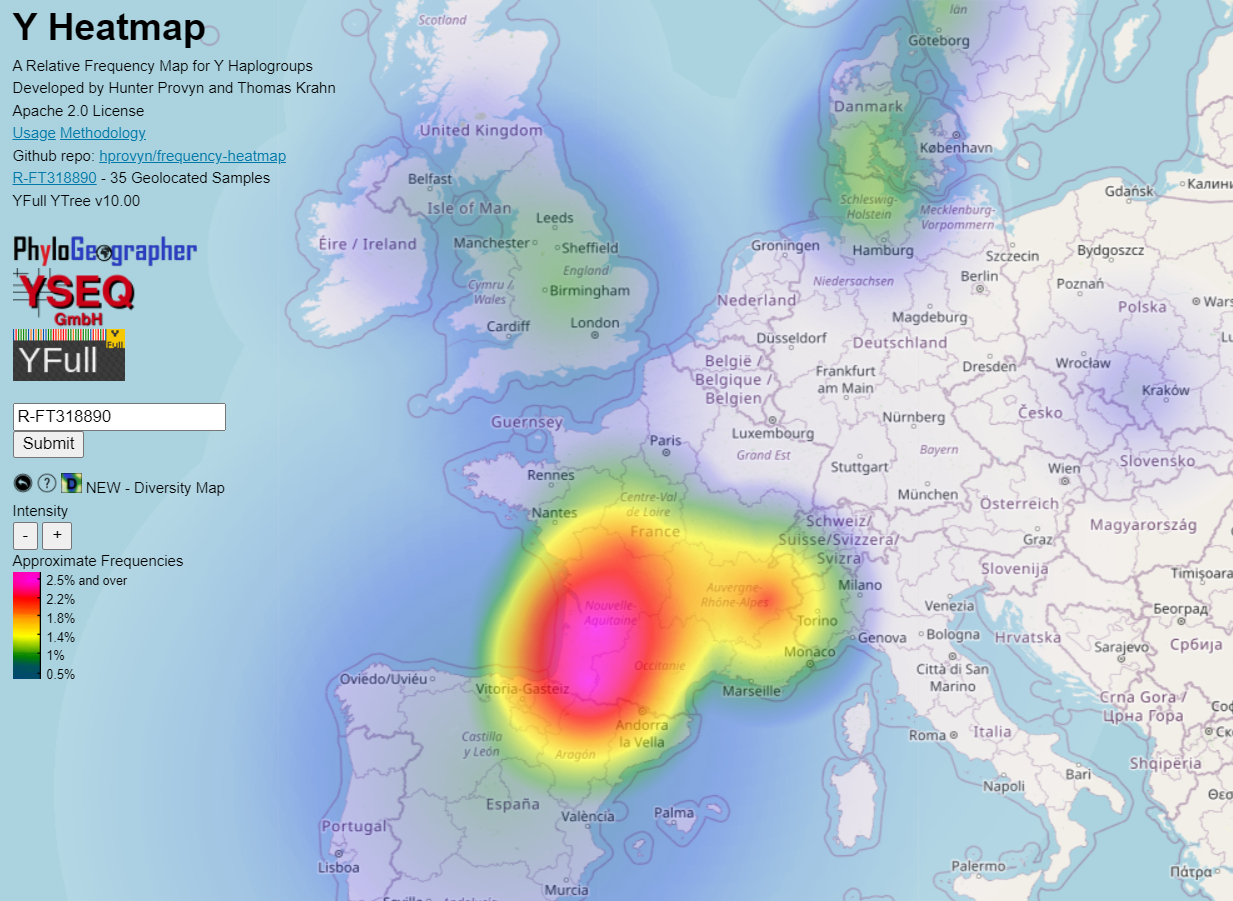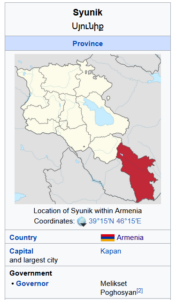An adopted man who got the J-L283 result from 23andMe contacted me to help him determine his male line origins.
Based on an autosomal match he thought he might be of the Huggins male line, so he sent me the STRs of one of these men. It turns out that his Huggins relatives are not J-L283 but are a branch R1b-DF27 below R-FT318890.
While widely distributed throughout western Europe today, many of the subclades of R1b-DF27 have highest frequency and diversity in northeastern Iberia.
However, R-FT318890 has higher diversity and relative frequency on the other side of the Pyrenees, in southwestern France.

Even though France is undersampled per capita relative to Iberia, England and Scandinavia, Y Heatmap takes into account these sample rates and is able to create the above visualization from the regionally geolocated samples on the YFull tree.
French-Armenian Child Lineage R-Y42667
Interestingly, one of these lineages migrated to Armenia. YFull estimates that their most recent common ancestor with men from Isère, France lived 1150 years ago.
The most recent common ancestor of the exclusively Armenian branch is estimated to have lived 550 years ago. These men are all from Syunik, the southernmost province of Armenia.

Based on these estimates, and assuming a deeper origin in France based on the upstream diversity, their ancestor appears to have migrated from France to Armenia sometime between 970-1470 CE.
One historical connection I can find that may link these dates and geographies is the House of Lusignan from Poitiers, western France.
"In 1342, Amalric's son, Guy de Lusignan, was elected as King of Armenia (Cilicia) and took the name Constantine II." - House of Lusignan
It should be noted that this is referring to the Armenian Kingdom of Cilicia. This was a state founded by Armenians fleeing the Seljuks, though some Armenians lived in the area since the conquests of Tigranes the Great.
I don't know if there are historical records of any of these men from Armenian Cilicia, after the fall of their state to the Mamluks in 1374, going back to Armenia or specifically Syunik. In fact, the Wikipedia article only mentions migrations to France and Cyprus.
However, given that the circumstantial evidence matches an otherwise far flung migration I think it would be worth investigating for those interested in this lineage.
The next closest relatives of these men is a guy from Silesia with ancestral surname Honkisz. His most recent common ancestor with this France-Armenia lineage, R-Y41710 (R-Y42559 on FTDNA), lived about 1500 years ago. Given that his next closest relatives include a guy from Gironde, their common ancestor was also probably living in France around 500 CE.
Star-Like Phylogeny of R1b-DF27
There is a big difference between the R1b-DF27 trees on YFull and FTDNA. FTDNA is using a number of branches defined by SNPs that are 100% identical (or nearly so) with 1000 SNP long segments found elsewhere on the Y or X chromosomes. This means that it is impossible using current technology to determine which segment one's results actually correspond to. I suspect this is why the SNPs Z31644, ZZ19_1, ZZ12_1 and TT1/Z46512 are not on the YFull tree.
Maybe in time additional more reliable SNPs will be discovered through WGS testing, in regions not covered by Big Y, to replace these other SNPs that, while likely indicative of common descent, cannot be proven to have originated from one particular segment vs another.
I did notice that one R-DF27 backbone SNP FGC78762 is not homologous to other segments and have recently suggested YFull to take a look at it. Later I realized that this is in the centromere which I don't think they use.
If they are able to add this SNP to the tree, or discover a more reliable SNP denoting the same branch, it will unite about two dozen lineages of R-DF27. Needless to say this would be a huge step forward in advancing the R-DF27 phylogeny.
It would be interesting to view the Y Heatmap for R-FGC78762 to see if this parent exhibits a distribution similar to that of R-FT318890 in centered around SW France.
I’m curious about the FGC78762 issue. Has there been any progress? Also, I don’t understand what it means to say that it isn’t homologous to other segments. Would you please explain?
Actually the subject matter experts in Armenian history believe that for a man of French origin to migrate to this part of Armenia, the vector may have been Catholic Church-mediated. I.e. the ancestor of the Armenian branch may have been a priest or other church official who migrated from Europe to Armenia.
We say that two segments of DNA are homologous if the sequences closely match or are identical. Sometimes a similar segment from a different chromosome gets used to overwrite a particular segment as a repair mechanism. Because of this, a mutation on a segment that is homologous to other segments is less stable – any particular instance of such a mutation could have originally occurred in situ or on the homologous segment and been subsequently copied over.
A Catholic priest ancestor? That seems…unlikely… But not unheard of. Thank you for the informative reply. It seems the “huge step forward” hasn’t happened yet.
Hi I recently discovered my father is ZZ19_1. And indeed I couldnt find it in Yfull tree. So does it mean that of that lineage there are no people in the yfull tree? So if he were to take a big 700 test there would be zero matches?